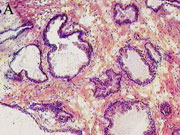Nevertheless, conclude researchers at the University of Bristol, speculation over the role of screening and treatment for prostate cancer will continue until evidence from randomised controlled trials is published. Their study and conclusions are published online today (17 April) in The Lancet Oncology.
In the USA, prostate cancer screening based on the prostate-specific antigen (PSA) test, is almost routine. In 2001, 57% of men aged 50 years or older reported having a PSA test within the previous 12 months. By contrast, for each year between 1999 and 2002, an estimated 6% of men aged 45-84 were tested in the UK.
However, there is no robust evidence that routine PSA testing decreases prostate cancer mortality. Previously published comparisons of USA/UK prostate cancer trends – using data up to the late 1990s – showed that mortality rates in the USA and UK had begun to fall, albeit more rapidly in the USA, but the changes seemed too early to be attributed to the effect of PSA testing.
Simon Collin, from the University of Bristol, UK, and colleagues analysed trends in prostate cancer mortality in both countries between 1975 and 2004, and compared them with trends in screening and treatment.
They found that mortality rates peaked in the early 1990s and then began to decline, but after 1994, the rate of decline of mortality in the USA (4.17% per year) was almost four times that in the UK (1.17% per year). The mortality decline in the USA was greatest and most sustained in patients aged 75 years or older, whereas death rates stabilised in this age group in the UK by 2000.
The authors say that the difference in mortality could be related to different treatment and screening policies in the two countries – for example the greater use of gonadotropin-releasing hormone treatment in older men, or more aggressive treatment of men with locally advanced and asymptomatic prostate cancer found through greater PSA testing in the USA. Another factor could be the misattribution of cause of death.
They conclude: “The decline in mortality from prostate cancer in the USA is striking in comparison to the UK, but we can only continue to speculate about the relative contributions of differences in detection and treatment, or the relative balance of benefits and harms, until the publication of findings from trials provides the robust evidence that is so eagerly awaited.”
In addition, the findings from this paper give support to the views from the British Association of Urological Surgeons that many recommendations in recently released UK NICE Guidance are unfounded, inappropriate and risk worsening mortality rates in the UK from prostate cancer.

